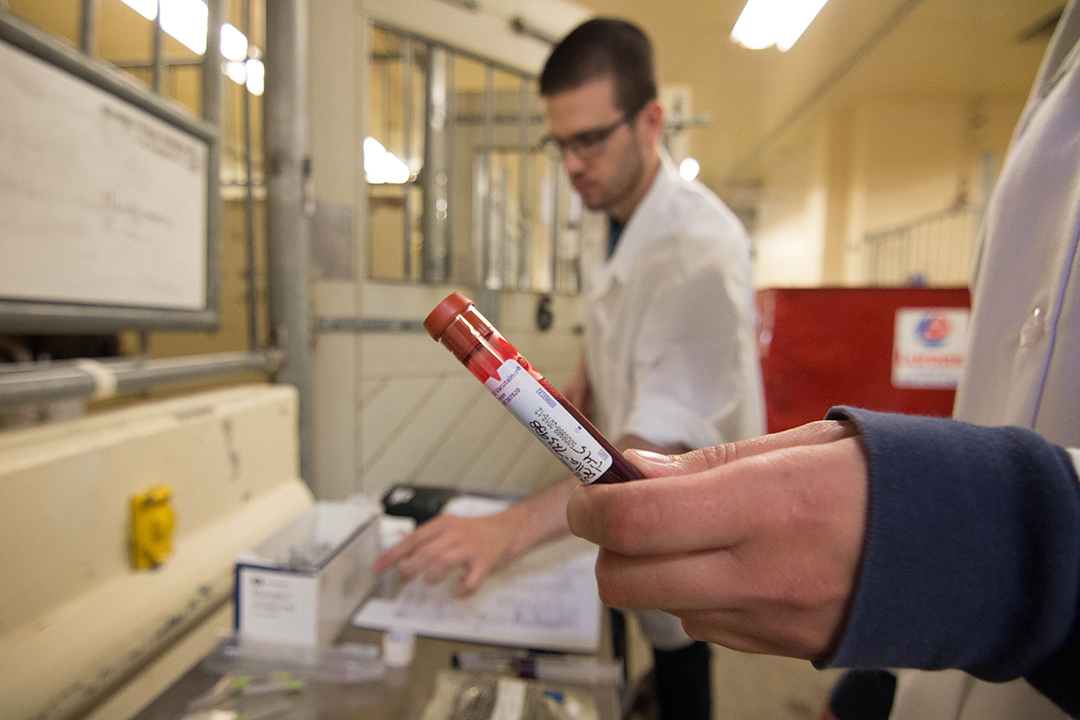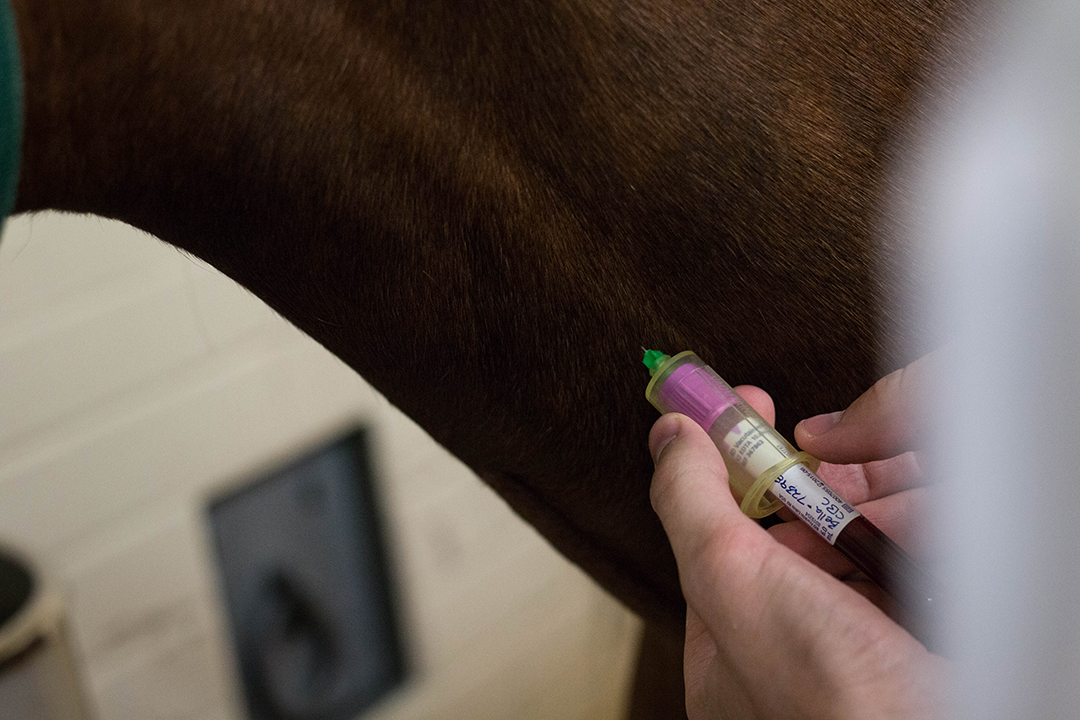
Hormone baseline for horses in the West
How do levels of insulin and other hormones in western Canadian horses compare to hormone levels measured in horses living in other parts of Canada and around the world?
By Myrna MacDonaldIt’s a question that Dr. Julia Montgomery aims to answer through a collaborative study with Prairie Diagnostic Services (PDS), Saskatchewan’s provincial veterinary diagnostic laboratory. Once published, the study’s results will help to establish reference values for hormones that accurately reflect the horse population in Canada’s western provinces.
“From a veterinarian’s perspective, establishing western Canadian reference values is one of the bigger benefits from this study,” says Montgomery, an associate professor in the WCVM’s Department of Large Animal Clinical Sciences.
Another big benefit for veterinarians and horse owners will be regional access to testing for common endocrine diseases. By 2022, PDS will be equipped to offer a full range of endocrine testing to western Canadian veterinary clinics — including the WCVM Veterinary Medical Centre.
Right now, diagnosing these diseases in less than a week just isn’t possible for western Canadian veterinary clinics. Samples must be sent to veterinary diagnostic laboratories at the University of Guelph in Ontario or at Cornell University in New York before veterinarians can gain a complete diagnostic picture of their equine patients. Because of the distance, wait times vary from five to 10 days with the chance of shipping issues causing further delays in receiving results.
This initiative is a great example of the collaboration between the veterinary college and PDS, whose laboratories and diagnostic facilities are based in the WCVM building. It’s also a group effort: the WCVM’s equine clinicians gather blood samples, the endocrine laboratory team in the college’s Department of Veterinary Biomedical Sciences validate tests, and PDS co-ordinates the activities and eventually offers the tests.
“It’s a real symbiotic relationship,” points out Montgomery. “We recognize what’s needed on the clinical side, and we can help give input in what’s a worthwhile investment. As for PDS, they have all the expertise in house that makes it possible to realize these types of projects.”
Measuring levels of hormones such as insulin, adrenocorticotropic hormone (ACTH) and thyroxine (T4) is critical for accurately diagnosing and treating equine metabolic syndrome (EMS), pituitary pars intermedia dysfunction (PPID) and thyroid disorders such as hypothyroidism. Endocrine disorders such as PPID and EMS are diseases related to the hormone-producing glands of the horse’s body. Older horses and ponies that are obese are at higher risk for these diseases.
“This is really important because these diseases are so common, and they’re going to become more common as our horse population ages,” says Montgomery, who receives at least one or two endocrine-related calls a week while on shift at the WCVM’s Large Animal Clinic. “As well, we’re seeing more obese horses — the obesity problem is not going to go away any time soon.”
Having these tests available in Western Canada will mean a faster turnaround for results, which means treatment protocols can begin sooner. Horses diagnosed with EMS can develop laminitis while horses with PPID can have a number of chronic problems associated with immunosuppression, such as chronic sinusitis or corneal ulceration. Some horses even suffer from both PPID and EMS at the same time.
“We can also be more confident about whether a test is positive or negative when we have reference values for our own horse population in our geographic area,” adds Montgomery. “Comparing the results of a horse to values that were obtained from horses in the same population — and not from a population in another region — is very important. We can be more confident in these fine-tuned results.”
As Montgomery explains, geography as well as seasons can affect baseline hormone levels in horses: “We know that there is a seasonal variation — that’s very well documented. But we also know that it can be different based on geographical location, which is likely linked to daylight length. This has been shown in studies done on both northern and southern hemispheres.”

Beginning this spring, Montgomery and other WCVM clinicians will collect blood samples from at least 40 client-owned healthy horses and from 20 or more horses diagnosed with PPID. The team will collect these samples during farm visits by the WCVM’s Equine Field Service or during regular appointments at the WCVM Veterinary Medical Centre.
Horses recruited for the study will be sampled once for insulin and T4 — measurements required for EMS diagnosis or diagnosis of thyroid disorders. The WCVM team will also collect samples for the hormone ACTH, which is an essential measurement for diagnosing PPID. Since normal ACTH values can vary by season, WCVM researchers will collect samples from the study’s horses in the spring and fall — about five months apart.
WCVM veterinarians will provide owners with their respective test results free of charge, along with a written report about their findings and recommendations. Owners can request further testing or therapies for their horses, but they will be responsible for any additional fees.
Having a full range of equine endocrine tests available in Western Canada will help to make the WCVM and other western Canadian veterinary clinics more self-reliant — a trait that has proven to be especially critical during the COVID-19 pandemic with the heightened demand for medical supplies and services.
In another effort to help horse owners, the WCVM Veterinary Medical Centre’s pharmacy now offers the thyrotropin-releasing hormone (TRH) stimulation test, a dynamic test used to diagnose PPID.
“It gives us a way to bring out the horses in the ‘grey zone’ when they could be in the early stages of this disease and results from a baseline ACTH test aren’t clear enough,” says Montgomery.
She adds that this particular test is only available for use by WCVM clinicians since it contains products compounded in the college’s pharmacy. As Western Canada’s veterinary referral centre, Montgomery says it’s critical for the WCVM to continue improving the standard of care available and to stay up to date with diagnostic and clinical services.
“We also need to be more proactive in helping other western Canadian veterinary clinics have access to these types of tests,” says Montgomery. Her hope is that this equine-focused project will lead to more mutually beneficial efforts between PDS and WCVM: “It’s a great collaboration.”
For more information about enrolling your horse in the endocrine study, contact Dr. Julia Montgomery (julia.montgomery@usask.ca).
Visit the WCVM Townsend Equine Health Research Fund website to read more stories in the Spring 2021 issue of Horse Health Lines.
